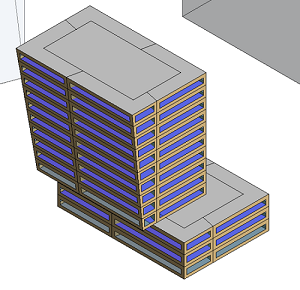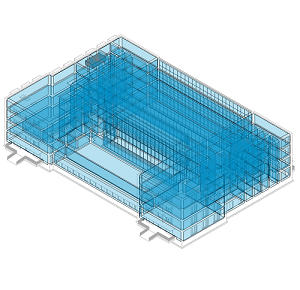Breaking a building into parts to capture variations in heat transfer processes
The basic purpose of Space discretization is to capture the building’s interior and exterior heat exchanges with a sufficient level of resolution to create a valid energy simulation.
It’s always tempting to think of Spaces as essentially the same as the ‘rooms’ in a building. While there is often a direct correlation (such as a cellular office or a meeting room as a discrete Space), it’s not always that straightforward. For example, it is often necessary to sub-divide very large rooms (such as an open plan office or an atrium) so that the heat transfer processes are represented more accurately.
While the term Space ‘discretization’ sounds complex, it comes from the computational methods that performance simulation is based on. It also provides clear differentiation from ‘Zoning’, ‘Blocking’ and ‘Chunking,’ which can have a broader meaning.
In order to understand Space discretization, consider the following series of illustrations using a simple notional building seen in cross section…
|
Cross section of a conceptual building
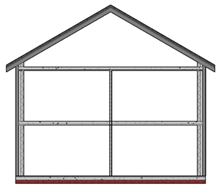
|
Assuming this cross section shows the extents of the building, how manySpaces do you think should exist? Let’s explain some options.
|
|
No Space Discretization (1 Space)
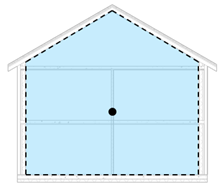
|
The basic problem with no discretization is that all heat gains and losses are essentially lumped together into a single Space, and this doesn’t accurately represent the physical phenomena that occur in the building. For example, if at some instant in time there was a large heat loss through a north roof and also a large heat gain through a south wall, this single Space would be assumed to only experience the net sum of this heat gain and loss. In reality, the localization of those losses and gains may need to be treated by local heating or cooling.
Thus the simulation results would underestimate the amount of actual heating and cooling required.
|
|
By Level (3 Spaces)

|
The next step up from this could be to consider discretization by building level. While this is certainly better than a single Space, and it could be adequate in some cases like in the roof Space (where there is likely no heating or cooling), this would likely still suffer from the same issue of not being able to separate simultaneous heat gains and losses sufficiently.
|
|
By rooms (5 Spaces)
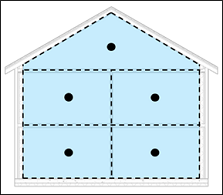
|
Given the form of this example, the most obvious Space discretization is by the ‘rooms’ in the building. The overall building now looks like it has been broken up into sufficient Spaces for the energy simulation to be able to separate simultaneous heat gains and losses, and thereby determine the energy required to maintain comfort throughout the building more reliably.
However, there may be a catch. What if any of these ‘rooms’ contained a large and localized heat gain, like the lighting systems in a theatre? In this case, the distribution of heat is not essentially even throughout the Space – an indication that you may want to further break-up the space.
|
Going further than discretization by rooms, we can divide the Space by depth, height, or both. It is worth being aware of the basic principles involved in this level of discretization because makes the reasons for certain EAM authoring practices clearer (‘Zoning’, ‘Blocking’ or ‘Chunking’).
|
By rooms + depth (9 Spaces)
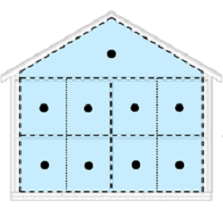
|
Discretization by depth is more common than you might think, and is especially applicable for conceptual forms in which the interior layout, rooms and Zones have not been defined yet. ASHRAE 90.1 Appendix G (LEED) energy modeling contains rules on ‘thermal blocking’ that require discretization by orientation and perimeter depth. The image below a simple floor plan discretized by depth according to these ASHRAE guidelines.
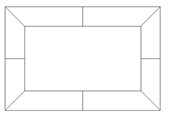
|
|
By rooms + height (9 Spaces)
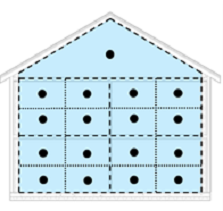
|
Discretization by height is less common but can be beneficial for simulating tall open rooms like atria, where human occupants are likely to be at the bottom of the space. Creating different spaces based on height can also account for stratification effects from under-floor air distribution systems, and for more precise heat gains and losses like the theatre lighting example. |
|
By rooms + depth + height (17 Spaces)

|
Then of course there are also potentially cases when it can be beneficial to discretize rooms by depth and height. At this point the EAM can almost start to resemble a coarse form CFD model of sorts although this kind of EAM and energy simulation is extremely advanced. Depending on the activities, geometries, and thermal loads of the building, capturing this level of resolution can be important for valid results.
|
‘Chunking’ or ‘Blocking’ during Space Discretization
Space discretization also offers the opportunity to use fewer Spaces than the number of rooms. The
practice of combining rooms into single Spaces is extremely common in manually authored EAMs and is often variably called ‘Zoning’, ‘Blocking’ or ‘Chunking.’
It can be valid to combine several rooms into one Space if they have the same orientation, depth, and function. Sometimes this is computationally efficient, though better automatic space discretization combined with cloud simulation is making this less important.

In this row of small offices on the same elevation of a building, you could combine rooms into a single Space (left) or Separate Spaces for each room (right)
Similar considerations can be made for things like ceiling voids over rooms. The need to actually model ceiling voids as discrete Spaces depends on the depth (deeper = more important) and/or if the ceiling void is being used as a supply or extract plenum (a detailed HVAC system design decision). Manual authoring of Spaces and Surfaces for ceiling voids typically adds a large cost to EAM authoring.

Combine ceiling voids with one Space (LHS) or Separate Spaces for ceiling voids (RHS)
Vertical voids can also be accounted for in several different ways within an Energy Analysis Model.
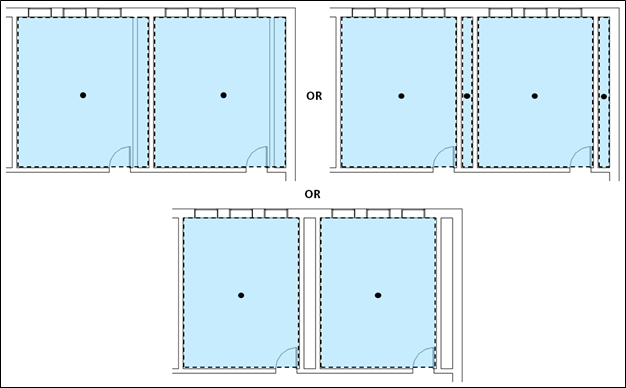
Combine voids with one Space (left), Separate Spaces for voids (right) or Omit voids (Bottom)
There are some drawbacks to combining Spaces, including a tendency to: 1) misrepresent floor area and building volume, and 2) underestimate thermal mass and radiant temperature effects.
The main reason for these practices in manual EAM authoring is ease of creating and maintaining the model, and improving the model’s stability and performance. However, combining spaces can obscure the reliability of the model and there is an inevitable tradeoff at some point with accuracy and precision. The effectiveness of blocking or chunking is highly subject to a user’s skill, time and preference.
Space Area
Floor area of a space. Used for specifying interior loads like occupancy and lighting.
Space Area essentially relates to the floor area over which internal heat gains and power consumption due to things like Occupancy, Lighting and Equipment are present. As these processes are often specified on a per unit floor area basis, particularly at early design stages, the accuracy of Space Area is important. However, it is also ultimately somewhat relative especially when you consider the numerous other associated assumptions like operating schedules that dictate actual energy end use.
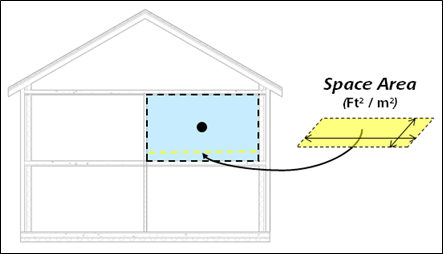
Space Area is the floor area, and is measured by square feet or square meters.
In current industry practice, it is not uncommon to see a deviation of plus or minus 5-10% between the Space Area of a manually authored Energy Analysis Model and the actual floor area of the building. While high level of precision is not always necessary, especially for comparative studies, the potential for such inconsistency can undermine confidence in the model and create challenges for reliable repeatability of results. Furthermore from a ‘BIM perspective,’ 5-10% is a pretty huge error and we can surely do better with greater ease.
Space Volume
The quantity of air in a Space not its ‘shape’
As mentioned earlier Spaces are discrete masses of air that experience heat loss or gain. Space Volume on its own represents the quantity of air in a Space.
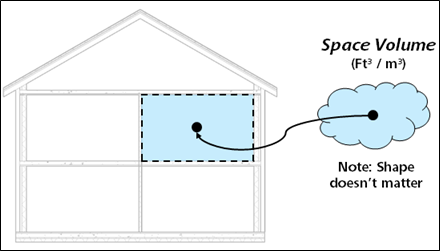
Space Volume is the quantity of air in the space, and is measured by cubic feet or meters.
It’s worth noting that while the Volume is typically thought about as the ‘shape of the air’ and is often illustrated graphically in many EAM authoring tools as such, the actual shape is not considered by the energy simulation engine. Rather, the Volume is simply some discrete mass of air.
Given the low density and specific heat capacity of air, an energy simulation is usually not especially sensitive to Volume. Consequently, it does not typically have to be defined very accurately to have valid energy analysis results. This is important because Volume can be difficult or very expensive to determine accurately.
